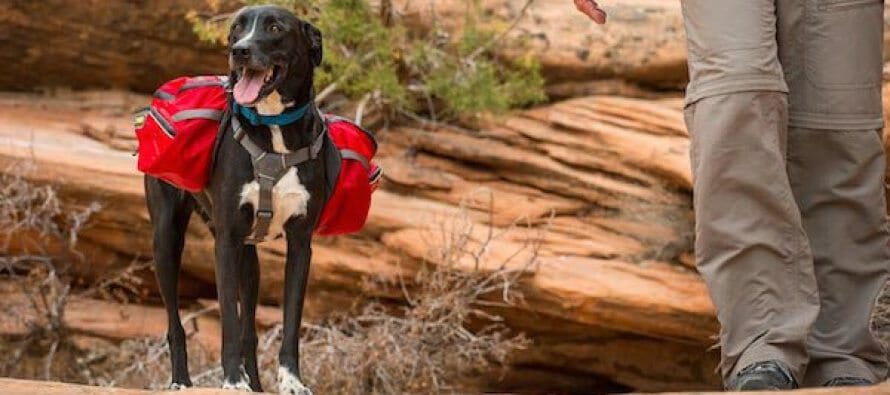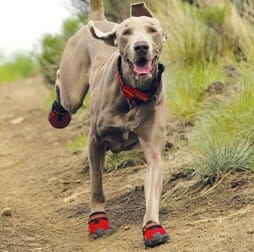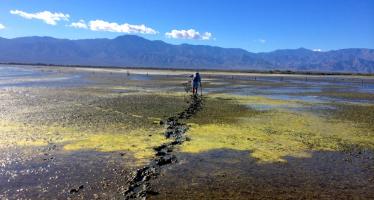
Hiking with your dog
Whenever I get out my hiking or backpacking gear, it’s my dog, Kiwi, who is the most excited about the trip. She loves coming along, but it’s important for any dog owner who is planning on heading out into the wilderness with a furry companion to keep him or her safe and to be knowledgeable of your pet’s physical boundaries.
Kiwi and I have been on an outdoor adventure nearly every weekend for the past 4 years, ranging from backpacking most of the Appalachian and Pacific Crest trails in stretches to canoe-camping for a week in the Cascades of Washington state. Here’s what we’ve learned.
Trail Regulations and Etiquette
Always check on the dog regulations for the areas where you’ll be backpacking. Most U.S. national parks, for example, do not allow dogs to share the trail.
Maintain control of your dog at all times. Dogs are required to be on-leash at most maintained public trails. Most require a leash to be 6 feet or less in length, so I advise ditching your extendable leash. It may be great for everyday romps around the neighborhood to give your dog more freedom, but it’s rarely sturdy enough to live up to trail conditions.

Use a leash when hiking with your dog
Having your dog on a leash isn’t enough. You should also be sure to keep him or her calm as other people and pooches pass by. Be aware of what situations will upset or aggravate your furry friend. If he or she is still getting used to other dogs, you might want to hold off on hiking for now.
When I was helping Kiwi learn her trail manners, I was careful to pick trails that didn’t have a lot of traffic or I would go off-season. Although some trails don’t require leashes, I usually make the choice to keep Kiwi on hers, especially when hiking trails are shared with mountain bikers. Although Kiwi is a great hiking companion, she often can’t help but want to run up to dogs and children when she sees them, so I play it safe. Doing the research on the area you’ll be visiting is the most important thing you can do to make sure you’re knowledgeable and don’t put your dog in danger.
Is Your Dog Physically Ready?
Ease your dog into the routine of hiking. If you want your pet to carry some of the load, start off by having him or her wear a pack around the house, then on short walks, then longer walks.
You should also start with lighter loads. It’s safe to work to up to one-third of your dog’s weight if your dog is in healthy physical condition. For dogs who are older or in poor physical condition, consider leaving them at home with friends, They’ll be much happier… and safer, too.
First-Aid Preparedness
Be prepared. Sites such as peteducation.com have a lot of great info about dogs, including many articles about first aid. Petco and the Red Cross offer first-aid classes, which I recommend highly, to offer you hands-on help.
Once Kiwi got quite a gash from a coyote she ran into. I was lucky enough to have a friend who was a vet on the trip, but quickly learned how important it is to make sure one is ready to take care of their dog no matter what circumstances arise. I carry pet first aid kit, which also comes with a great book to help you with what to do on the trail.
Shop our selection of dog safety gear.

Dog pack
You’ve done your research, and your pooch is ready to go. Let’s start packing!
Food and Water
Hydration is crucial for an active dog. Some dog packs feature a nifty built-in hydration system for watering dogs. You can also consider collapsible food and water dishes. Kiwi is so hungry by the time we stop that I’ll usually just pour her food on a rock to cut a bit of weight when packing.
Depending on size, your dog should usually be able to carry his or her own food and water. Do your research to make sure there’s going to be plenty of water to filter where you’ll be backpacking. Be sure to pack enough for both of you if there’s nowhere to get more. Dogs are susceptible to giardia protozoa much like humans, so be sure to filter and/or treat their water just as you would if you were going to consume it.
As for food, I feed Kiwi nearly double what I would on a daily basis if it’s a really strenuous trip. Check with your vet to ensure your dog will be getting the right amount of calories for the estimated energy that will be expended. Your vet is also a great resource to advise on the exercise level that is right for your dog.
Tip: One vet told me that to prevent dehydration, you can mix some Pedialyte with your dog’s water. My dog is about 60 lbs, and I mix in about 20cc’s with a bowl of water. Be sure to check with your vet beforehand to see how much is safe for your friend.
Sleeping Gear
This depends on what the weather is going to be like—or how extreme it might get—for the days you’ll be on the trail.
I remember one very chilly night when Kiwi actually snuck her way into the bottom of my sleeping bag. Eventually, I surrendered the bag to her and opted to sleep in my down jacket. I thought bringing along a self-inflating sleeping pad for her would be enough, but as she has short hair I quickly (and painfully) learned that when temps drop below about 50 degrees I need to bring along a bag for her as well.
I’ve opted for a kid’s bag, but some of my friends carry ultralight 2-person bags so that they can snuggle with their pooch when the temperature drops very low. It all depends on your pup, the breed and learning what they need to be comfortable. It’s better to overpack the first time and learn than bring too little to keep your pal cozy.
Kiwi doesn’t just lie on top of the sleeping bag; she waits for me to open it and gratefully climbs right in. Sometimes I find it easier to unzip the bag, have her lie on top of it and then zip her in. When it’s raining I’ll usually have her rest under the rainfly on her mat until she dries off a bit. Sleeping is no fun when you’re a sopping wet dog, especially when it’s going to get really chilly.
In addition to sleeping gear, give some thought to your dog’s attire. Indoor dogs and breeds with thin coats can benefit from an outer layer to preserve body temperature in cold, wet conditions.
Dog Vest and Coats
Kiwi loves her dog coat when it’s chilly, and something I also learned is that she really benefits from having her underside covered when we’re going to be backpacking in the snow. You might choose this type of jacket to ensure your dog’s belly stays nice and warm, especially when you’re in deep snow.
If you’re going to be hiking in a very hot environment, you might consider a dog vest. You can soak it with water to dissipate heat as the water evaporates. On the other temperature extreme, consider a fleece bodysuit that covers your dog’s entire body and legs. This suit is overkill when your dog is working hard during the day, but I’m sure any dog would appreciate PJs when it’s chilly at night. In fact, some dogs do just fine with an extra layer and no sleeping bag at night.
Dog Boots

Dog boots
One of Kiwi’s least favorite items is her dog booties. When I lived back in Michigan, I made her wear them nearly all winter because the salt used on the sidewalks was quite damaging to her paw pads. Now, I usually just bring them with me. If I see her paws are getting chilly I’ll slip them on.
Likewise, once she got a small cut on rocky terrain, and she was very thankful for the extra protection. I will whip out her boots, much to Kiwi’s dismay, when there is any snow on the ground, when it’s raining and near freezing temperatures, when we’re scrambling up rocky areas or if we’re on rock and it’s above 70 and sunny.
It may take a few tries for you to find the right pair that don’t fall off your dog when tromping through snow. I recommend testing out your boots on short walks and hikes before any big trips. Kiwi looked a little ridiculous and confused the first time I adorned her in footwear, but now she’s thankful to have it when it’s necessary.
Fitting and Loading a Dog Pack

Pack weight varies by breed
How Much Weight is OK?
As mentioned above, your dog can help carry the load. In general, young and healthy dogs can carry up to 25% of their weight. Some breeds can carry 10% to 15% more, while other breeds aren’t cut out to carry much at all. The amount you should pack also changes with age. Once again, this is a good topic to discuss with your vet.
How to Fit a Pack
Your first step is to measure the circumference of your dog’s chest. Most packs have a specific size so you can find the corresponding measurement. Then place the middle of the pack on your dog’s back. Straps usually fasten around the waist, chest and/or around the neck. Adjust all straps to tighten the pack to fit your dog’s body. Don’t pull too tight, as you’re not going anywhere if your dog can’t breathe. Be aware that a too-loose pack can slip off.
Types of Packs
Dog packs made specifically for mobile hydration hold a few items that are great for trail runs or shorter day hikes. Other packs are made specifically fortraining and exercise. Packs that work best for backpacking will have more volume and extra padding to provide comfort on your dog’s frame.
Pack Features

Dog food dish
All packs are designed to provide adequate weight distribution for your pet. Other common features:
- Dividers: So that you can keep food and water separate from any other supplies.
- Collapsible food dish: Fits perfectly inside the pack or sometimes zips on the outside.
- Pocket for a cooling insert: You keep the cold pack in your freezer and insert it into the pack before heading out; great for hot climates.
- Top handle: Makes it easy to hang onto your dog if you’re crossing a shallow river or up on a small ledge.
You should also consider a waterproof pack if there’s a chance you’ll be in a lot of rain or snow. Also, the pack I use with Kiwi when I run is reflective and even has a spot to place a light. This really helps out with visibility, as many mornings in the Northwest are pretty foggy or sunless.
Water Safety for Dogs
Are you planning to enjoy an alpine lake, cross a shallow river or paddle to your trailhead? Consider these safety concerns when your dog is going to be near the water.
Doggie PFDs (Personal Flotation Devices)
Not all dogs are natural swimmers, which is why a PFD (a.k.a. “life jacket”) can make sense. There are a couple of main considerations for shoppers:
- Type of activity: Heavy-duty models are meant for whitewater environments or rivers; others are designed for recreation on still lakes. There are even jackets that help your dog learn how to swim or provide assistance when they tire themselves out.
- Amount of buoyancy: This is based on the size of your dog.
PFD Features and Fit
The key PFD necessities are proper fit and great visibility. Sizes are based primarily ony a dog’s girth measurement, which is the widest part of the rib cage. It should be snug, so that it doesn’t slip off, but loose enough so as not to restrict your dog’s mobility. Visibility comes into play by making certain that you, as well as those driving boats and paddling, can see your dog. So, though you think Buffy looks her best in deep purple, it may not be the best from a safety perspective.
A handle, just like the one on my backpack, is something that is imperative on a PFD. Once Kiwi got a little too excited while we were paddling on the lower portion of the Gully River in West Virginia, and she hopped out while we were running through a slow-moving stretch. I was easily able to grab her from up top and help her get back into the boat with ease.
The Coast Guard does not currently approve canine life jackets, so it’s best to do your research and splurge on a well-known brand. Though chain pet stores have a less expensive selection of generic life jackets, it’s definitely worth spending a little more to ensure your dog’s safety if you’re planning on frequenting the water with your friend. It should last you a long time.
Drinking Safety

Dogs and backcountry water
It’s always good advice: Watch what your dog drinks! Water in lakes and rivers can contain algae or parasites that can make your dog sick or even cause death in extreme cases. Keep plenty of fresh water on hand and train your dog to drink out of his or her bowl.
This works well, but Kiwi’s love of chasing the waves means she always ends up ingesting a lot of water if I let her have this freedom. I learned that salt water can be extremely unpleasant. Now, I make sure I don’t let her play too long when we’re near the ocean. Ensure that your dog drinks a lot of fresh water afterwards; salt dehydrates dogs.
Post-swim
It’s important to remove the salt, chemicals and extra stuff that may be floating in the water and end up on your dog’s coat. Also, if you have a dog with ears that flop down it’s a good idea to rinse out their ears or at the very least make sure you dry them out to help prevent any infection or irritation.
Again, each dog is different. Some dogs will plop down when they start to get worn out, but others will play until you make them stop, even when they are exhausted. It’s better to be safe than put your dog in danger, so learn your dog’s limits slowly so that you can ensure they enjoy the water safely.
Toys
There are lots of dog toys that float or glow to make your day at the beach or an alpine lake more fun.
Other Dog Hiking Considerations
Additional Gear
This is just the beginning of the gear you can invest in to make the outdoors a safe and fun place for your dog. A few other examples:
- Dog harnesses for more technical trails or climbing
- GPS beacons and leashes that fasten to you via carabiners
- Dog-specific bike trailer
- Dog tent (Not all dogs like these for overnights, but they can double as sun shelters.)
- Leashes (I prefer using a waistbelt system so I don’t have to hang on while I run; while backpacking, I like a leash I can clip to my pack.)
- Cooling collars for hot days
- Creams that help breeds that don’t need boots stay comfortable in the snow.
Disposing of Waste
Let’s be honest here. Taking your dog means you must clean up after the both of you. Make sure you bury all pet waste just as you would your own—at least 200 feet away from trails, camps and water sources.
Post Trip
At trip’s end, be sure to check your dog’s body for ticks, burrs and other objects. If you do find a tick, I recommend contacting your vet. There are different dangers for pets regionally, so a vet can help you decide if you should remove the tick yourself or come into the office. Also, I wash Kiwi with some medicated shampoo, as the plants that brush up against her can sometimes irritate her belly since she doesn’t have a lot of fur on it. However, most dogs will be fine with a quick bath.
Dog Resources
Best Hikes with Dogs is a series of guidebooks specific to different geographic areas.
In addition, there are some great blogs to learn more. I subscribe to the Ruffwear blog, and I read the Raise a Green Dog blog, which helps you find eco-friendly dog products that are safe for your dog and the environment.






